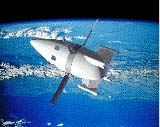31 January 1999
Helicopter Heads For Space
 A US based team proposes to build a reusable orbital helicopter which can carry people and light cargo to space for a fraction of the cost of conventional rocket vehicles. This patentable vehicle concept is called Roton. It can be operated from almost anywhere without a launch site or ground support equipment.
A US based team proposes to build a reusable orbital helicopter which can carry people and light cargo to space for a fraction of the cost of conventional rocket vehicles. This patentable vehicle concept is called Roton. It can be operated from almost anywhere without a launch site or ground support equipment.
The development cost of Roton is modest compared with other launch systems. This is due to three important advantages of the Roton system. First, the vehicle is reusable and inherently reliable due to the configuration. Even during most failures the Roton will be recoverable intact. Second, the vehicle is small and uses off-the-shelf equipment and cheap propellants. Third, the development can be conducted by a small team of less than a dozen skilled designers and technicians, making extensive use of subcontractors.
Roton was invented by Bevin McKinney, commercial space entrepreneur and Chief Designer of American Rocket Company. McKinney, who has spent fifteen years working in the field of low-cost rocketry, conceived the basic Roton idea. McKinney pioneered the development of hybrid rocket motor, firing hundreds of such devices during the 1980s, and flew the first commercially-funded rocket, the Dolphin. He is joined by another commercial space businessman, Gary C. Hudson. Hudson is known principally for his work on single-stage-to-orbit reusable spaceships, which has found expression in the $70 million DC X SSTO program funded by the US Government, and for which he was awarded an Aviation Week "Laurel" in 1994.
Roton combines previously developed technologies into a unique new concept for a space transport machine. As early as the late 1940s, rocket engines were built which used the centrifugal pumping power of a rotary arrangement to provide the energy to force propellants into the combustion chamber. The "cyclo-rocket" developed at Aerojet in 1946 was the first to employ this approach, though it failed to take the next logical step and use the actual centrifugal forces produced by spinning the rocket around in a circle to provide direct pumping power; rather it converted the rotary engine motion into shaft power to run a centrifugal pump. (Hero's steam engine is a simple expression of one element of this concept.) By positioning rocket engines at the tip of a rotating blade or propeller, the energy produced by the engine thrust can be made to spin the blade and to providethe desired pumping power. While in the sensible atmosphere, the rotor can also generate efficient thrust, often improving the rocket engine thrust by a factor of ten. This has the result of reducing the propellant consumption by the same factor. By combining this technique with the very high pressure being produced by the rotary action, engine efficiency can reach to the near ultimate available for liquid fuel rocket systems. This permits a vehicle to be built using inexpensive propellants (liquid oxygen and aviation kerosene) and with a loaded to empty weight ratio of better than 15 to 1. We believe this to be within the state of the art to manufacture.
The rotor serves an additional important function during re-entry. By acting as a combination rotary wing and large drag brake (depending on orientation of the blades), the rotor can either slow the vehicle high in the atmosphere (reducing frictional heating) or extend the crossrange and downrange glide capability of the vehicle, improving landing performance and decreasing the decelerative loads on cargo and crew. Re-entry performance superior than the winged Space Shuttle is predicted to be possible.
Roton vehicles would be able to takeoff from any level ground--for example the taxiway of a small county airport. No rocket blast touches the surface, eliminating the need for any sort of launch support equipment. Only kerosene and liquid oxygen, both common industrial chemicals, need be supplied to the vehicle. A small Roton, capable of carrying one person, will require only a few thousand dollars worth of propellant. While noise would be substantially greater than a small aircraft, the noise footprint is very compact and the high speed departure from the field would minimize the impact on the surrounding site. Upon landing, the much lighter vehicle would be significantly quieter, comparable to a conventional helicopter.
